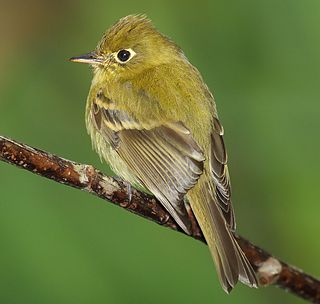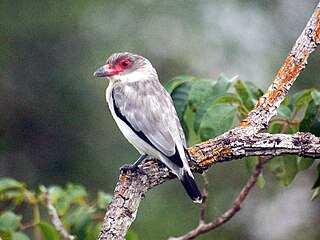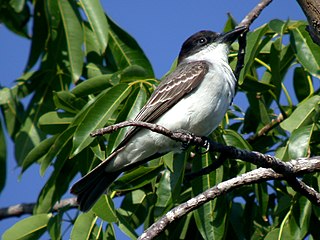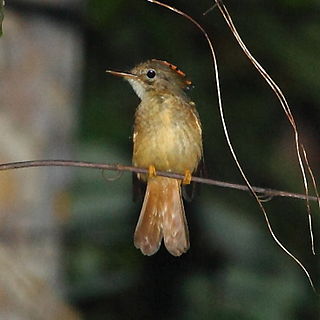
The cotingas are a large family, Cotingidae, of suboscine passerine birds found in Central America and tropical South America. Cotingas are birds of forests or forest edges, that are primary frugivorous. They all have broad bills with hooked tips, rounded wings, and strong legs. They range in size from 12–13 cm (4.7–5.1 in) of the fiery-throated fruiteater up to 48–51 cm (19–20 in) of the Amazonian umbrellabird.

The tyrant flycatchers (Tyrannidae) are a family of passerine birds which occur throughout North and South America. They are considered the largest family of birds known to exist in the world, with more than 400 species. They are the most diverse avian family in every country in the Americas, except for the United States and Canada. The members vary greatly in shape, patterns, size and colors. Some tyrant flycatchers may superficially resemble the Old World flycatchers, which they are named after but are not closely related to. They are members of suborder Tyranni (suboscines), which do not have the sophisticated vocal capabilities of most other songbirds.

The Tyranni (suboscines) are a suborder of passerine birds that includes more than 1,000 species, the large majority of which are South American. It is named after the type genus Tyrannus.

The black-tailed tityra is a medium-sized passerine bird of tropical South America. The tityras have been placed in the cotinga or the tyrant flycatcher families by various authors. But the weight of evidence strongly suggest they and their closest relatives are better separated as Tityridae; the AOU for example advocates this separation.

The cinnamon becard is a passerine bird found in Latin America.

The white-crowned manakin is a small passerine bird in the manakin family Pipridae. This common and extremely widespread manakin is one of the most easily identified, even in female plumage. It is a resident breeder in the tropical New World from Costa Rica to northeastern Peru and eastern Brazil. It was traditionally placed in the genus Pipra, but is now placed in its own monotypic genus Pseudopipra. It is a small, compact bird about 10 cm (3.9 in) long. Males have black plumage with a white crown which can be erected as a crest, the only member of the Pipridae to possess both an all-black body and a gleaming white crown. Females and juveniles are olive-green, with a grey head and throat, and greyish-green or olive underparts. At breeding time, males are involved in a lekking behaviour. This is a fairly common species with a wide range, and the International Union for Conservation of Nature has rated its conservation status as being of "least concern".

The tityras are passerine birds in the genus Tityra of the family Tityridae. They are found from southern Mexico, through Central America, to northern and central South America, including Trinidad.

The rose-throated becard is a medium-sized member of the family Tityridae. Its genus, Pachyramphus, has traditionally been placed in Cotingidae or Tyrannidae, but evidence strongly suggest it is better placed in Tityridae. This species was named in honour of Aglaé Brelay.

The cattle tyrant is a species of bird in the tyrant-flycatcher family Tyrannidae. In Brazil, it is called suiriri-cavaleiro. It is the only member of the genus Machetornis. The relationships of this species and genus to other genera in the tyrant flycatchers are uncertain. It resembles Tyrannus flycatchers, but this may be the result of convergence. Three subspecies are recognised, the nominate race, M. r. flavigularis and M. r. obscurodorsalis, although the latter two may not be distinct from M. r. flavigularis. The genus name was given to the species by George Robert Gray and is derived from the Ancient Greek makhētēs for fighter and ornis for bird, a reference to its pugnacious behaviour and habit of dispossessing other species of their nests. The specific name comes from the Latin rixosus meaning quarrelsome, again referring to the behaviour and temperament of the species.

The whiskered myiobius or bearded flycatcher is a species of bird in the family Tityridae, having previously been included in Tyrannidae. A number of taxonomic authorities continue to place with the flycatchers. The whiskered myiobius is found in Brazil, Colombia, Ecuador, French Guiana, Guyana, Peru, Suriname, and Venezuela. Its natural habitats are subtropical or tropical moist lowland forests and heavily degraded former forest.

The tawny-breasted myiobius or tawny-breasted flycatcher is a species of passerine bird in the family Tityridae. It is found in Bolivia, Colombia, Ecuador, Panama, Peru, and Venezuela. Its natural habitat is subtropical or tropical moist montane forests.

The northern royal flycatcher is a passerine bird in the family Tityridae according to the International Ornithological Committee (IOC). It is found in Mexico, south through most of Central America, to northwestern Colombia and far western Venezuela.

The Pacific royal flycatcher is a species of passerine bird in the family Tityridae according to the International Ornithological Committee (IOC). It is found in western Ecuador and northwestern Peru.

A becard is a bird of the genus Pachyramphus in the family Tityridae.

The Jamaican becard is a species of bird in the family Tityridae. Its genus, Pachyramphus, has traditionally been placed in Cotingidae or Tyrannidae, but evidence strongly suggest it is better placed in Tityridae.

The giant kingbird is a species of bird in the tyrant flycatcher family Tyrannidae endemic to Cuba.

The yellow-cheeked becard is a passerine bird in the family Tityridae. It is treated variously as a distinct species or as a subspecies of the green-backed becard, Pachyramphus viridis. It has traditionally been placed in Cotingidae or Tyrannidae, but evidence strongly suggest it is better placed in Tityridae, where now placed by the South American Classification Committee. It is mainly found in Ecuador and Peru.

The Amazonian royal flycatcher is a passerine bird in the family Tityridae according to the International Ornithological Committee (IOC). It is found in throughout most of the Amazon basin in northern Bolivia, eastern Peru, eastern Ecuador, eastern Colombia, Venezuela, the Guianas, and northern and western Brazil.

Tityridae is family of suboscine passerine birds found in forest and woodland in the Neotropics. The 45 species in this family were formerly spread over the families Tyrannidae, Pipridae and Cotingidae. As yet, no widely accepted common name exists for the family, although tityras and allies and tityras, mourners and allies have been used. They are small to medium-sized birds. Under current classification, the family ranges in size from the buff-throated purpletuft, at 9.5 cm (3.7 in) and 10 grams, to the masked tityra, at up to 24 cm (9.5 in) and 88 grams. Most have relatively short tails and large heads.

Ceratopipra is a genus of passerine birds in the family Pipridae.

























